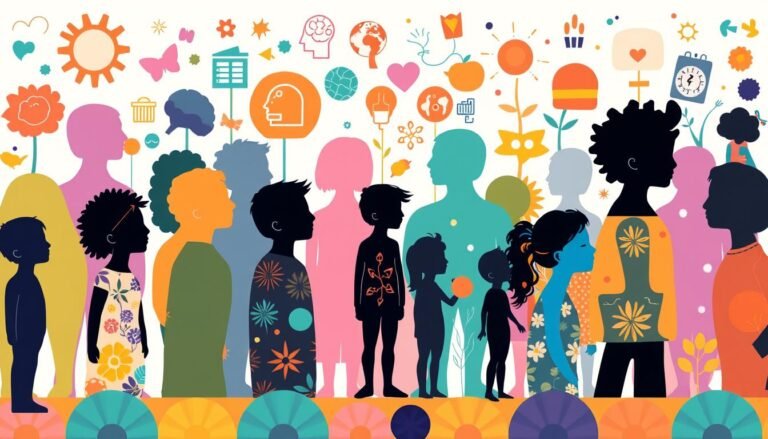Introversion vs. Extraversion: Understanding Differences
Imagine you’re at a lively party. The room is filled with people talking, laughing, and music playing. You see someone in a corner having a deep conversation with a few others. On the other side, someone is moving from group to group, full of energy.
These people show us introversion and extraversion. These traits affect how we interact with others and how we get our energy.
Our personality shapes how we see the world. Some like quiet time, while others love being around people. Knowing these differences helps us understand ourselves and others better. It makes our communication and relationships stronger.
Carl Gustav Jung first talked about introversion and extraversion in 1910. He helped us understand these traits better. Today, we know these traits are on a spectrum. This means most people are a mix of both.
It’s interesting that more people are extroverts than introverts. This might explain why our society often favors outgoing people. But, it’s important to remember that both types have their own strengths and challenges.
Key Takeaways
- Introversion and extraversion are key personality traits influencing social behaviors.
- These traits exist on a spectrum, with most people falling somewhere in between.
- Extroverts outnumber introverts by approximately 3:1.
- Understanding these differences can improve communication and empathy.
- Both introverts and extroverts have unique strengths in various situations.
Defining Introversion and Extraversion
Introversion and extraversion are key parts of personality theory. Carl Jung first introduced these terms. They describe how people interact with the world.
Carl Jung’s Original Concepts
Carl Jung was a pioneer in understanding personality. He saw introversion as focusing inward on personal experiences. On the other hand, extraversion is about looking outward at the world.
Modern Psychological Understanding
Today, psychologists see introversion and extraversion as a spectrum, not just two types. This view helps us understand personality better. It also introduces the idea of ambiversion, a mix of both traits.
The Introversion-Extraversion Spectrum
The spectrum helps us place people based on how they react to the world. Most people are somewhere in between, showing traits of both introversion and extraversion.
| Trait | Introverts | Extraverts |
|---|---|---|
| Energy Source | Solitude | Social Interaction |
| Preferred Group Size | Small | Large |
| Response to Stimuli | Internal Factors | External Factors |
| Thinking Style | Introspective | Extrospective |
Knowing about introversion and extraversion helps us in many areas. It’s key for social interactions, career choices, and personal relationships. Remember, both traits have their own strengths.
Key Characteristics of Introverts
Introverted traits shape unique social behavior and energy management patterns. Introverts often feel most at ease in quiet, low-stimulus settings. They value deep connections, preferring small gatherings or one-on-one interactions to large social events.
A 2015 study revealed that high-quality relationships play a crucial role in introverts’ overall happiness. This aligns with their tendency to cultivate a small circle of close friends rather than a vast network of acquaintances.
Introverts excel at observing human behavior. A 2018 study found they make more accurate observations compared to extroverts. This keen insight stems from their thoughtful nature and preference for listening over speaking.
Energy management is a key focus for introverts. They recharge through solitude, finding social interactions draining over time. Dr. Tworek notes that introverts process information best when alone, highlighting their need for quiet reflection.
| Introverted Traits | Impact on Behavior |
|---|---|
| Preference for solitude | Recharges energy, enhances creativity |
| Thoughtful observation | Accurate insights into human behavior |
| Small social circles | Deep, meaningful relationships |
| Low-stimulus environments | Improved focus and productivity |
While introverts may face challenges in managing emotions, as suggested by a 2020 study, they possess strengths in stress management. Their comfort with quietness and introspection can be powerful tools for navigating life’s complexities.
Essential Traits of Extraverts
Extraverted traits greatly affect how people interact with their surroundings. They shape social behavior, energy sources, and how we communicate.
Social Behavior and Preferences
Extraverts love being around others. They seek out fun activities and enjoy being the center of attention. A study shows that 77% of extraverts prefer exciting holidays, compared to 47% of introverts.
Energy Sources and Stimulation
Unlike introverts, who recharge alone, extraverts get energy from others. They feel alive after social events and can get bored when alone for too long. This is why 87% of extraverts think they have strong leadership skills.
Communication Styles
Extraverts are great at talking. They think out loud and love to have lively conversations. An impressive 89% of extraverts feel at ease saying thank you out loud, showing their comfort with social interactions.
| Trait | Extraverts | Introverts |
|---|---|---|
| Seek thrilling activities | 77% | 47% |
| Comfortable with verbal gratitude | 89% | 67% |
| Believe in leadership potential | 87% | 56% |
These traits influence how people handle social situations, get energy, and talk to others. Knowing these traits can help us understand ourselves better and improve our relationships with others.
The Biological Basis of Personality Types
Personality neuroscience has uncovered the biological roots of introversion and extraversion. It shows that brain functions are key in where we fall on this spectrum.
Introverts are more sensitive to sensory inputs than extraverts. This is seen in their quicker responses to sound. Introverts and extraverts also differ in how their muscles react.
Genetics also play a big part in our personality. Twin studies show that identical twins are more alike in introversion or extraversion than fraternal twins. But, culture and life experiences also shape our traits.
Neurotransmitters like dopamine and acetylcholine influence our personality types. Dopamine is linked to being outgoing, while acetylcholine is tied to being more reserved. This supports Hans Eysenck’s idea that our biology affects our personality.
| Trait | Introverts | Extraverts |
|---|---|---|
| Sensory Stimulation | Higher reactivity | Lower reactivity |
| Auditory Response | Faster brainstem latencies | Slower brainstem latencies |
| Associated Neurotransmitter | Acetylcholine | Dopamine |
While biology is important, remember that personality traits can change. They evolve as we grow, showing the mix of nature and nurture in our personalities.
Introversion vs. Extraversion in Social Settings
Social interactions and group dynamics are key in how introverts and extraverts handle social situations. Knowing these differences can make communication and relationships better.
Preferred Group Sizes
Introverts and extraverts have different comfort levels with group sizes. A study of 28 young adults showed interesting social preferences:
| Personality Type | Preferred Group Size | Comfort Level with Strangers |
|---|---|---|
| Introverts | Small (1-3 people) | Low |
| Extraverts | Large (5+ people) | High |
Reactions to Social Stimuli
Research using event-related potential (ERP) showed that extraverts have a bigger P300 when seeing human faces. This means they pay more attention to social cues. It explains why they love being around people.
Social Energy Management
Introverts and extraverts manage their energy differently in social situations. Introverts, making up 25% to 40% of people, get tired after being social and need time alone. Extraverts, however, get energized by being around others and look for ways to interact.
“Introverts tend to spend a significant amount of time examining their own internal experiences and prefer learning through observation rather than through trial and error.”
Understanding these differences can improve group dynamics and make places more welcoming for both introverts and extraverts.
Career Considerations for Introverts and Extraverts
Knowing your personality type can really shape your career. Introverts and extraverts do best in different work places. This affects how they grow professionally and how happy they are at work.
Introverts do well in quiet, focused jobs. For example, finance and IT jobs are great for them. These jobs let them work alone, which they prefer, and they like using email more than talking.
Extraverts, however, love busy, team-based jobs. They do well when they’re around people and things happening. Success for them often means making money, being famous, or getting status.
| Personality Type | Preferred Work Environment | Communication Style |
|---|---|---|
| Introverts | Quiet, solitary | Written (e.g., email) |
| Extraverts | Active, collaborative | Verbal, face-to-face |
Most people are a mix of introverted and extraverted. Using these traits at work can make them happier and more productive. Choosing a career that fits their natural strengths can lead to lasting success.
Misconceptions and Stereotypes
Many myths surround introversion and extraversion, causing confusion. Let’s clear up some common stereotypes and find the truth about these personality types.
Introversion vs. Shyness
Many think introverts are shy or socially anxious. But, introverts just prefer quieter places and smaller groups. They do enjoy socializing, but in their own way.
Extraversion vs. Social Skills
Some believe extraverts are naturally better at socializing. But, social skills are learned, not based on personality. Introverts can be just as skilled in their comfort zones.
Debunking Common Myths
Let’s tackle some common misconceptions about introverts and extraverts:
| Myth | Reality |
|---|---|
| Extraverts like people, introverts don’t | Both types enjoy social interactions, but in different ways |
| Introverts are shy, extraverts are not | Shyness is not related to introversion or extraversion |
| Extraverts are loud, introverts are quiet | These traits vary among individuals regardless of personality type |
| Introverts are antisocial | Introverts enjoy socializing but prefer smaller groups or one-on-one interactions |
| Extraverts are always confident | Confidence is not dependent on personality type |
Understanding these misconceptions helps us value the unique strengths of introverts and extraverts. It promotes a society that welcomes all personality types.
The Concept of Ambiversion
Ambiversion is at the heart of the personality spectrum, mixing introversion and extraversion. People with this type can easily fit into different social situations. Studies show that more than half of us are ambiverts, showing how common this flexible nature is.
Ambiverts do well in many areas because they can adapt easily. In sales, they make 24% more than introverts and 32% more than extraverts. Their skill in listening and talking helps them balance being assertive and empathetic.
Ambiverts also shine in school. They often get better grades than others. This is because they can switch between socializing and studying, showing the benefits of being adaptable.
- Strong self-awareness
- Excellent communication skills
- Flexible behavior regulation
- Balanced decision-making abilities
But, ambiverts also face challenges. They might feel tired from playing different roles. It’s hard to spot ambiverts because they change based on where they are. Understanding this helps us see the complexity of personality and the importance of balance in our society.
Conclusion
Understanding introversion and extraversion gives us valuable insights into personality diversity. This knowledge helps us grow personally and improve our relationships. It was first introduced by Carl Jung in 1921 and has become a key part of modern psychology.
Research shows that these traits have a biological basis. Twin studies suggest that genetics play a role in how outgoing we are. Brain studies also show differences between introverts and extraverts, proving that personality is linked to biology.
Early life experiences, like parenting, can also shape these traits. It’s important to note that most people are somewhere in between introversion and extraversion. Even introverts can find happiness in being more outgoing sometimes.
Accepting and valuing these differences is key. It helps us work better together and grow personally. This is true in both social settings and at work.
Source Links
- Introvert vs. Extrovert Personality: What’s The Difference?
- Introvert vs Extrovert: Difference Between Introverts & Extroverts
- Differences between Extraversion & Introversion & its Types
- Introversion and Extroversion: Definitions, Origins and Examples – Introverts Corner
- Are you an introvert, extrovert, or in the middle? How to tell, plus pros and cons of each
- Introvert vs. Extrovert: What’s The Difference?
- Energy: Introverted (I) vs. Extraverted (E) | 16Personalities
- Introvert vs Extrovert
- Biological bases of extraversion: psychophysiological evidence – PubMed
- Extraversion and introversion
- Introverts vs Extroverts: A Comprehensive Guide
- Do extraverts process social stimuli differently from introverts?
- Am I am Introvert? These 8 Signs Will Help You Decide
- Introverts’ vs. Extraverts’ Career Path | Personality Junkie
- How to Work with Introverts and Extroverts – GovLoop
- Misconceptions and Stereotypes for Extraversion and Introversion
- 7 Myths About Introverts and Extroverts That Need to Go
- What Is an Ambivert Personality? Introvert & Extrovert Mix
- Introvert, Extrovert, or Ambivert: The Psychology Behind Personality Types
- Extraversion And Introversion
- Introversion vs Extraversion – Practical Typing








